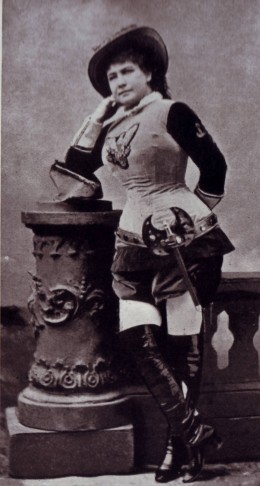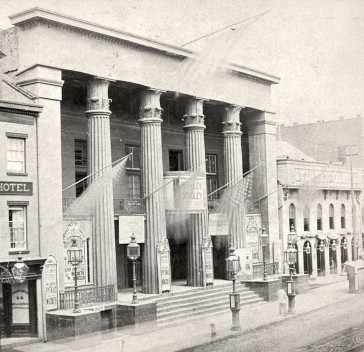Kurt Gänzl
The Encyclopedia of the Musical Theatre
18 October, 2001
Born in Graz to theatrical parents, Geistinger first went on the stage as a child and had an early exposure in Vienna when, at 16, she appeared in the title-rôle of the Posse Die falsche Pepita (Theater in der Josefstadt, 1852).

Marie Geistinger as Offenbach’s Helena, one of her greatest theatrical triumphs.
She did not follow up this success in Vienna but instead, over the next dozen years, moved on to Berlin, Hamburg, Riga and Berlin again, appearing mainly in juvenile light-comedy rôles in plays, including many with song and dance elements. She returned to Vienna in 1865 at the bidding of Friedrich Strampfer, director of the Theatre an der Wien, to introduce the title-rôle of Offenbach’s Die schöne Helena (La Belle Hélène) to Viennese audiences. This show and this rôle established her as a musical-theatre star, and she followed up as Offenbach’s Boulotte (Blaubart, 1866), Coscoletto (Coscoletto, 1866), La Sincère (Die Schäfer ie Les Bergers, 1866), Die Grossherzogin von Gérolstein (1867) and Drogan (Genovefa von Brabant), as Emma in Julius Hopp’s Die Donauweibchen (1866) and in a whole list of smilar rôles under Strampfer’s direction, before herself taking over the part-direction of the theatre in tandem with his successor, Maximilian Steiner.

Marie Geistinger as a cross-dressing “Bettelstudent”.
She appeared at the Theater an der Wien in a wide variety of rôles in both plays and musical plays (Leni in Alois Berla’s Drei Paar Schuhe, Anna Birkmeier in Der Pfarrer von Kirchfeld etc), and made another personal hit in an Operette — this time an Austrian one — when she starred as Fantasca in Johann Strauss’s early piece, Indigo und die vierzig Räuber (1871). Continually varying plays and Operetten, she was seen in the Viennese productions of Offenbach’s Le Corsair noir (1872) Die Theaterprinzessin (1872, La Diva, Susi Apfelwein) and Fantasio (1872, Fantasio), starred as Leokadia Blumenau in Millöcker’s Abenteuer in Wien (1873), in Offenbach’s Die Wilderer (Les Braconniers, Ginetta) and Madame l’Archiduc (Marietta), and as Wosana in Jonas’s Die Japanesin (1874). She rejoined Strauss for Carneval in Rom (1873, Marie) and again, in 1874, to create the rôle of Rosalinde in Die Fledermaus, introducing `Dieser Anstand’ with Jani Szíka, and the famous csárdás `Klänge der Heimat’, and yet again as the first Lorenza Feliciani in Cagliostro in Wien (1875).
In spite of her considerable successes, the tenuous financial climate in Vienna following the stock-market crash of 1875 found Geistinger in a parlous monetary state.
Although she continued at the Theater an der Wien, playing in such pieces as Offenbach’s Les Brigands (1875, Fiorella) and a version of La Créole (1876, Antoinette), she was finally obliged to give up her part of the management of the theatre.

Marie Geistinger as Boccaccio, in Vienna.
After more than a decade as Vienna’s reigning queen of musical theatre, she moved on to profit from the high fees available from guest performances and to take up dramatic rôles at the Stadttheater. She then proceeded to Leipzig where she once again mixed drama, comedy and Operette during a stay of more than two years, returning to Vienna and the Theater an der Wien in 1879 to introduce her first successful new rôle for a number of years as the German version of Offenbach’s Madame Favart. She also played in the `scene aus den Österreichischen Alpen mit National-Gesangen’, Das Versprechen hinter’m Herd, and in 1880 was seen as Lotti in Die Näherin and as Stella, the heroine of Offenbach’s Die Tochter des Tambour-Major.

The Thalia Theatre (= Bowery Theatre) New York in July 1867.
Gustav Amberg, the proprietor of one of New York’s flourishing German-language theatres, now proposed her a long and lucrative American engagement and, in 1881, the 44-year-old star crossed the Atlantic and made her début at Amberg’s Thalia Theater (5 January 1881) as Offenbach’s Grande-Duchesse, to the sort of reception she had had in Vienna 20 years earlier (`she plays it as high comedy rather than rollicking bouffe’, `she is quieter than Aimée and touches the double entendres so that they are funny without being coarse’, `she sinks her personality in each character … a great artist’). Geistinger extended her American stay over more than three years, playing across the whole country and appearing regularly in New York as Madame Favart, Boccaccio, Boulotte, Rosalinde, Fatinitza, Leni in Drei Paar Schuhe, the schöne Galathee and the schöne Helena, in Carneval in Rom, Die Näherin, Der Seekadett, Madame Angots Tochter and a whole range of other musical pieces whilst also taking a turn in such dramatic rôles as Camille, Therese Krones, Elizabeth I in Graf Essex and Donna Diana in an ever-whirling repertoire.
After two seasons she moved to the rival Germania Theater and the Thalia promptly imported her celebrated Vienna rival Josefine Gallmeyer as competition.
However, Gallmeyer was mortally ill and soon returned to Europe whilst Geistinger continued to reign over the New York German theatre in a repertoire including such pieces as Capitan Nicol (ie I Carbonari), Durchgegangende Weiber, Lecocq’s Trompette (ie La Petite Mademoiselle, Countess Cameroni), Pariser Leben (Gabrielle), Leichte Kavallerie, Donna Juanita, Der Bettelstudent (Symon), Gallmeyer’s vehicle Das verwunschene Schloss (Regerl), Herve’s Lili (Lili), Sieben Mädchen und kein Mann (Suppé’s Operette with a reduced number of maidens), Die Afrikareise (Titania), Apajune der Wassermann (Natalitza) and Hennequin’s Die Kindsfrau with a score now credited to Millöcker, along with those already played in her earlier seasons. She also appeared in an original American-German Lokalposse, 1776 (1884, Marion), composed by the young Ludwig Englander.

The Viennese diva Marie Geistinger as the first Austrian Boulotte.
Back in Europe she appeared at Vienna’s Carltheater and in other theatres around Austria and Germany, scoring a particular success in the title-rôle of Therese Krones, and otherwise appearing still in the famous rôles of her earlier years, in such standard repertoire pieces as Die schöne Galathee, Boccaccio and Der Bettelstudent and, bit by bit, in marginally less central parts more suited to her age. She retired in 1889, but was forced by money problems to return in 1891 for a second American season, in 1896 for a third, and one last time in 1899 just before finally ending her memorable career at the age of 64.
In more recent times, Geistinger was musically portrayed on the stage by Elfie Mayerhofer as the heroine of the Operette Die Walzerkönigin (Ludwig Schmidseder/Aldo Pinelli, Hubert Marischka, Wiener Bürgertheater 1948) and on the screen in Willy Forst’s Operette, by Maria Holst. In the biomusical made on the life of Gallmeyer, however, the old rivalry was continued: although Treumann, Matras, Offenbach and Anna Grobecker were portrayed as characters in the piece, Geistinger was left out.
Biography: Pirchan, E: Marie Geistinger (Verlag Wilhelm Frick, Vienna, 1947)
